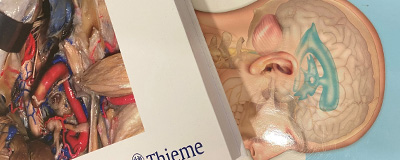The High Cervical Anterolateral Retropharyngeal Approach
Nabeel S. Alshafai, V. R. N. GunnessThe first high cervical anterolateral retropharyngeal (HCALR) approach was reported by Stevenson et al. for a clivus chordoma in 1966. Anterior approaches to the spine have often been developed in response to problems presented by tuberculous spondylitis. This approach is indicated in anterior high cervical spine cases such as tumour resection, abscess drainage, atlantoaxial subluxation; decompression and stabilization. To our knowledge, only 21 papers in the literature have mentioned this approach. Its main advantage over posterior approaches is easy positioning and minimal need for soft tissue dissection. The HCALR approach provides wide exposure (of the anterior upper cervical spine, lower clivus and brainstem region) and feasibility for instrumentation. The limited space in which important neurovascular and visceral structures course and overlap contributes to the complexity of the anatomy. Navigating this intricate anatomy is essential for the safety of this approach and has been a drawback for utilization of the retropharyngeal corridor. This approach is one of the safest and most effective methods available to access the craniocervical junction. The benefits clearly outweigh the risks and complications.
Occipito-cervical Fusion: An updated Review.
Nabeel S. Ashafai Massimiliano VisocchiNorbert WąsikAbstract
Occipitocervical fusion (OCF) is indicated for instability at the craniocervical junction (CCJ). Numerous surgical techniques, which evolved over 90 years, as well as unique anatomic and kinematic relationships of this region present a challenge to the neurosurgeon. The current standard involves internal rigid fixation by polyaxial screws in cervical spine, contoured rods and occipital plate. Such approach precludes the need of postoperative external stabilization, lesser number of involved spinal segments, and provides 95–100% fusion rates. New surgical techniques such as occipital condyle screw or transarticular occipito-condylar screws address limitations of occipital fixation such as variable lateral occipital bone thickness and dural sinus anatomy.
As the C0–C1–C2 complex is the most mobile portion of the cervical spine (40% of flexion-extension, 60% of rotation and 10% of lateral bending) stabilization leads to substantial reduction of neck movements. Preoperative assessment of vertebral artery anatomical variations and feasibility of screw insertion as well as visualization with intraoperative fluoroscopy are necessary. Placement of structural and supplemental bone graft around the decorticated bony elements is an essential step of every OCF procedure as the ultimate goal of stabilization with implants is to provide immobilization until bony fusion can develop.
Ipsilateral brain cavernoma under scleroderma plaque: a case report
Vimal Raj, Nitish Gunness, David Munoz, Pablo Gonzalez Lopez, Nabeel Alshafai, Agdaliya Mikhalkova, Julian SpearsAbstract
Scleroderma is a rare disease of unknown etiology, which is characterized by thickening and hardening of skin due to an increased collagen production. A 44-year-old female patient with a scleroderma on the scalp known by our department, also presented an ipsilateral brain lesion since 2015, which was showing growth without any clinical symptomatology and the patient wanted the lesion to be removed. This atypical lesion underneath the scleroderma shows that diagnosis can be missed without brain imaging and biopsy.
Introduction
Localized scleroderma encompasses the conditions of linear scleroderma (LS) (extremity and facial), plaque or circumscribed morphea, pansclerotic and generalized morphea. By definition, localized scleroderma involves the skin and the underlying tissue [1]. The most commonly described brain lesions in LS ‘en coup de sabre’ are intracranial calcifications, which are characteristically ipsilateral to the skin lesions and appear as hypo intense white matter lesions on T2-weighted magnetic resonance imaging (MRI) [2-4]. Cerebral angiograms and magnetic resonance angiogram studies may typically show vascular involvement suggestive of vasculitis. Reports of cerebral aneurysms and other vascular malformations, as brain cavernomas [1, 5, 6], exist and could represent late sequelae of a vasculitic process. To our knowledge there have been no case reports published showing a brain carvernous malformation ipsilateral to the scleroderma and beneath it in the adult population. However, we found 2 case reports in pediatric series.
The High Cervical Antero Lateral Retropharyngeal Approach
Massimiliano VisocchiThis issue of Acta Neurochirururgica presents the latest surgical and experimental approaches to the craniovertebral junction (CVJ). It discusses anterior midline (transoral transnasal), posterior (CVJ craniectomy laminectomy, laminotomy, instrumentation and fusion), posterolateral (far lateral) and anterolateral (extreme lateral) approaches using state-of-the-art supporting tools. It especially highlights open surgery, microsurgical techniques, neuronavigation, the O-arm system, intraoperative MR, neuromonitoring and endoscopy.
Endoscopy represents a useful complement to the standard microsurgical approach to the anterior CVJ: it can be used transnasally, transorally and transcervically; and it provides information for better decompression without the need for soft palate splitting, hard palate resection, or extended maxillotomy. While neuronavigation allows improved orientation in the surgical field, intraoperative fluoroscopy helps to recognize residual compression. Under normal anatomic conditions, there are virtually no surgical limitations to endoscopically assisted CVJ and this issue provides valuable information for the new generation of surgeons involved in this complex and challenging field of neurosurgery.
The Far Lateral Approach to the Craniovertebral Junction: An Update
Nabeel S. Alshafai, Tomasz KlepinowskiIntroduction: Since 1972, when Hammon first described the far lateral approach (FLA) for treatment of vertebral artery aneurysms, it has undergone numerous modifications, including drilling of the occipital condyle, removal of the laminas of upper cervical vertebrae and so on. Also, the range of indications has increased exponentially.
ObjectivesIn this paper we discuss state-of-the-art advances in the FLA, such as promising minimally invasive variants where an endoscope is used, and many others.
MethodsWe reviewed all articles touching upon the FLA in the modern era (from the year 2000 onward) and selected those that presented a significant contribution to the development of the relevant approach. The database used was PubMed.
Results and ConclusionWe found several new caveats not mentioned in other reviews or book chapters. The FLA is an ever-changing field of battle where the common and ultimate goals are to minimize the risk of injuring the major vessel in the region—the vertebral artery—and to provide such an angle of attack upon the tumours in the anterior and anterolateral foramen magnum that it is feasible to ensure gross total resection. This paper is an update on the knowledge about this approach, which we feel is necessary.
Extreme Lateral Approach to the Craniovertebral Junction: an Update
Nabeel Alshafai, Tomasz KlepinowskiAbstract
Introduction: The term ‘extreme lateral approach’ (ELA) was first introduced by Sen and Sekhar relatively recently (in 1990). Its definition varies and remains controversial, but it generally entails more aggressive bony removal than the far lateral approach (FLA).
Goal: In this paper we review the relevant literature and weigh up the advantages and disadvantages of this approach. We propose methods to manage the complications resulting from the more invasive character of the ELA. Some modern trends regarding how to definitely distinguish the ELA from the FLA are also presented.
Methods: Using the PubMed database, literature was collected on the relevant topics and subsequently reviewed. All up-to-date tips and tricks were carefully gathered, and current morbidity and mortality rates were obtained, as well as further perspectives.
Results and conclusion: The morbidity associated with the ELA remains higher than that associated with the FLA, but the mortality nowadays is comparable. The ELA undoubtedly is a challenging procedure requiring deep insight into the relevant anatomy and its normal variants.
Insights Into the Past and Future of Atlantoaxial Stabilization Techniques
Nabeel S Alshafai, Agnieszka Kramarz, Minou BehboudiAbstract
Over the past century, atlantoaxial stabilization techniques have improved considerably. To our knowledge there has been a scarcity of articles published that focus specifically on the history of atlantoaxial stabilization. Examining the history of instrumentation allows us to evaluate the impact of early influences on current modern stabilization techniques.
It also provides inspiration to further develop the techniques and prevents repetition of mistakes. This paper reviews the evolution of C1-C2 instrumentation techniques over time and provides insights into the future of these practices. We did an extensive literature search in PubMed, Embase and Google Scholar, using the following search terms: ‘medical history’, ‘atlantoaxial’, ‘C1/C2’, ‘stabilization’, ‘instrumentation’, ‘fusion’, ‘arthrodesis’, ‘grafting’, ‘neuroimaging’, ‘biomechanical testing’, ‘anatomical considerations’ and ‘future’. Many different entry zones have been tested, as well as different constructs, from initial attempts with use of silk threads to use of hooks and rod-wire techniques, and handling of bone grafts, which eventually led to the development of the advanced screw-rod constructs that are currently in use. Much of this evolution is attributable to advancements in neuroimaging, a wide range of new materials available and an improvement in biomechanical understanding in relation to anatomical structures.
Subacute combined degeneration of the spinal cord following nitrous oxide anesthesia: A systematic review of cases
Kishan K Patel, Juan Carlos Mejia Munne, Vimal Raj Nitish Gunness, Denise Hersey, Nabeel Alshafai, Daniel Sciubba, Rani Nasser, David Gimbel, Joseph Cheng, Aria NouriAbstract
Objective: Vitamin B12 deficiency can lead to subacute combined degeneration (SCD). Nitrous oxide (N2O) is an anesthetic which oxidizes the cobalt ion of vitamin B12, interfering with its function as a coenzyme. In this study, we conduct a systematic review of reported cases of SCD following nitrous oxide anesthesia.
Patients and methods: A comprehensive search of multiple databases was conducted, and information about patient characteristics, symptomatology, clinical work-up, and treatment was extracted from eligible articles. Univariate analyses were performed to identify predictors of poor neurological recovery following SCD.
Results: 32 studies, reporting 37 cases of nitrous oxide-induced SCD, were included through the screening process. These cases included 21 male patients and 16 female patients, with an average age of 50.4 years (SD 17.6). An etiology for subclinical B12 deficiency was determined in 30 reports; of these, 25 were due to vitamin malabsorption secondary to a gastrointestinal disorder. Duration of nitrous oxide exposure was described in 19 reports, and ranged from 30 min to 11 h. Univariate analysis failed to find an association between post-operative recovery and age (p = 0.60), sex (p = 0.46), positive MRI findings (p = 0.47), post-operative serum B12 (p = 1.00), post-operative hemoglobin (p = 0.18), type of surgery (p = 0.58), or post-operative high mean corpuscular volume (p = 0.13).
Conclusion: In patients with postsurgical myelopathy, surgeons should evaluate B12 status and consider the possibility that nitrous oxide could cause a subclinical B12 deficiency to become overt, particularly in patients with malabsorptive GI comorbidities. Treatment with B12 in this population can result in significant improvement of neurological function.
Surgical approach for suprasellar hemangioblastomas preserving the pituitary stalk: Review of the literature and report of a further case
Nabeel S. Alshafaia, Rodolfo Madurib, Mrigank Shailc, Domenico Chirchigliad, David Meyronete, Francesco SignorelliAbstract
Hemangioblastomas (HBLs) are challenging vascular tumours with rare suprasellar location Surgery is recommended in patients with visual impairment, endocrine disorders or hydrocephalus. Surgical removal of pituitary stalk HBLs is challenging due to their location and high vascularity.
Our narrative review was guided by the question: "what is the more suitable surgical approach to excise a suprasellar HBL?". Pertinent English literature was scrutinized from database inception to October 2016.
Eighteen articles matched our selection criteria. Among the surgically treated patients, 4 were treated through a trans-sphenoidal (TS) approach, 13 through a transcranial approach (2 of them after TS failure). Five other cases were treated with radiotherapy (adjuvant in 3 cases) and 9 patients were managed with simple observation and/or medical treatment. We add a case of complete suprasellar HBL resection through an orbito-zygomatic (OZ) craniotomy with extradural anterior clinoidectomy (EAC).
To achieve satisfactory oncologic results with acceptable morbidity for symptomatic suprasellar HBLs, complete tumour removal with pituitary stalk sparing should be attempted through an OZ craniotomy with EAC that provides adequate exposure of the tumour, its vascular supply and the adjacent neural structures.
Lack of Standardization in the Use of the Glasgow Coma Scale. Results of International Surveys
Florence C M Reith, Paul M Brennan, Andrew I R Maas, Graham M Teasdale Acknowledgement: Nabeel AlshafaiAbstract
The Glasgow Coma Scale (GCS) was introduced 40 years ago and has received world-wide acceptance. The GCS rates eye, motor, and verbal responses to assess the level of consciousness. Concerns have been expressed with regard to reliability and consistency of assessments. We considered that lack of standardization in application techniques and reporting of the GCS may have contributed to these concerns, and aimed to assess current procedures in its use. Questionnaire-based assessments were conducted by an online survey and during neurosurgical training courses. Overall, 616 participants were recruited, representing 48 countries and including physicians and nurses from different disciplines. Use of the GCS was reported by nearly all participants for assessment of patients with traumatic brain injury, but not for all patients with a reduced level of consciousness from other causes (78%).
Major differences were found regarding the type of stimulus applied when patients do not obey commands: Nail bed pressure, supraorbital pressure, trapezius or pectoralis pinch, and sternal rub were all frequently used, whereas 25% of responders reported to never use a peripheral stimulus. Strategies for reporting the GCS varied greatly, and 35% of participants limited the reporting to a summary score. Moreover, different approaches were used when one of the components could not be assessed. Overall, the surveys have identified a general lack of standardization in assessment and reporting of the GCS. The results illustrate the need for continued education to improve reliability of assessments through guidance to a standard approach.
Practices and Controversies in the Management of Asymptomatic Aneurysms: Results of an International Survey
Nabeel Alshafai, Olesya Falenchuk, Michael D CusimanoAbstract
Background: Asymptomatic aneurysms that are increasingly discovered on cranial diagnostic imaging are a growing management dilemma. Large-scale studies have shown that in most instances, conservative management is appropriate for the majority of patients with aneurysms less than 7 mm in maximum diameter. It is unclear whether international practise mirrors practise in these large trials.
Objective: To determine how neurosurgeons around the world manage patients with asymptomatic aneurysms.
Methods: Electronic survey of 283 clinicians managing patients with aneurysms using a 55-item questionnaire detailing characteristics of their experience, their hospitals and their present and future practises and insights regarding the management of patients with intracerebral aneurysms.
Results: The 203 neurosurgeons (72%) who responded had a median of 17 years of practise with aneurysms and managed a median of 25 aneurysms annually. The majority of neurosurgeons endorsed treatment of all asymptomatic aneurysms regardless of size. Only four out of 10 neurosurgeons would manage patients with 4 mm anterior communicating artery or middle cerebral artery aneurysms non-surgically, whereas fewer than 2% would conservatively manage asymptomatic patients with 10 or 16 mm aneurysms. Neurosurgeons were split as to the recommended techniques for asymptomatic aneurysms of 10 or 16 mm with about half of them electing clipping and half coiling for ACoA and nearly three quarters favouring clipping for the MCA aneurysm. Although international differences exist between Europe, North America and the rest of the world, most state that their choice of treatment related to decisions around what option would provide the best neurological outcome and prevention of long-term bleeding.
Conclusion: Despite large trials supporting the management of small asymptomatic aneurysms, most neurosurgeons internationally chooses to treat them with surgery or endovascular means. Since clinicians use a number of factors beyond the maximum diameter when considering treatment options, future trials should consider these factors in their design.
International Differences in the Management of Intracranial Aneurysms: Implications for the Education of the Next Generation of Neurosurgeons
Nabeel Alshafai, Olesya Falenchuk, Michael D CusimanoAbstract
Background: The publication of the International Subarachnoid Aneurysm Trial rapidly changed the management of patients with subarachnoid hemorrhage. The present and perceived future trends of aneurysm management have significant implications for patients and how we educate future cerebrovascular specialists.
Objective: To determine present perceived competencies of final-year neurosurgical residents who have just finished their residencies and to relate those to what practitioners from a variety of continents expect of these persons. The goal is to provide a basis for further discussion regarding the design of further educational programs in neurosurgery.
Methods: A 55-item questionnaire with 33 questions related to competencies and expectations of competency from final-year residents who have just finished residency was completed by 229 neurosurgeons and neuro-radiologists (81 % response rate) of mixed seniority from 45 countries. We used bivariate and descriptive analyses to determine future trends and geographic differences in cerebral aneurysm management as well as the educational implications on the future.
Results: More North Americans than those from the rest of the world are of the opinion that graduating residents are presently competent to perform basic cerebrovascular procedures like evacuation of a hematoma and clipping a simple 7-mm middle cerebral artery aneurysm. Extremely few graduating neurosurgical residents anywhere are presently capable of performing endovascular techniques for even the most basic of aneurysms. Most of those surveyed also believe that endovascular and open surgical management of aneurysms should be a part of residency training for all residents (70.4 and 88.7 %, respectively).
Conclusions: Our findings have implications for the design of neurosurgical curricula for residents as well as for certification examinations and procedures. Specialty and educational organizations and those responsible for the education of future clinicians who will care for patients with cerebrovascular problems should adjust educational objectives and implement curricula and learning experiences that will ensure that cerebrovascular specialists are capable of providing the best care possible to the patient with an aneurysm, whether that be open surgery or endovascular management. These findings mean that organizations around the world will need to make these adjustments to the education of future specialists.
Clinical and Surgical Predictors of Perioperative Complications in Patients with Degenerative Cervical Myelopathy: Results from the Multicenter, Prospective AO Spine International Study on 479 Patients
Michael G. Fehlings, Lindsay Tetreault, Nabeel Alshafai, Pierre Cote, Branko Kopjar, Helton Luiz A. Defino, Shashank Kale, Giuseppe Barbagallo, Ronald Bartels, Qiang Zhou, Paul M. Arnold, Mehmet Zileli, Gamaliel Tan, Yasutsugu Yukawa, Osmar J. Moraes, Massimo Scerrati, Masato TanakaAbstract
Introduction: Surgery for the treatment of cervical spondylotic myelopathy (CSM), although proven efficient, is not without associated morbidity and is typically accompanied by complication rates between 11 and 38%. By identifying important clinical and surgical predictors of complication development, clinicians can recognize their high-risk patients and institute appropriate prevention plans. This study was designed to identify important clinical and surgical predictors of perioperative complications in patients with degenerative cervical myelopathy.
International perspectives in the management of cerebral aneurysms: A study of 46 countries
Nabeel Alshafai, Michael D Cusimano, Olesya FalenchukAbstract
Introduction: The publication of the International Subarachnoid Aneurysm Trial and the International Study of Unruptured Intracranial Aneurysms rapidly changed the management of patients with subarachnoid hemorrhage in many countries. Future trends of aneurysm management will have significant implications for patients, health systems, and how we educate future cerebrovascular specialists internationally.
Methods: We describe past, present, and future trends in the management of patients with cerebral aneurysms. We recorded responses from 283 neurosurgeons and neuroradiologists in 46 countries. We explored similarities and differences in the availability and use of endovascular and open techniques of aneurysm treatment, imaging, and follow-up techniques, effectiveness and limitations of currently available techniques.
Results: More European respondents report that their hospitals perform coiling and fewer report that they perform stenting. The proportions of coiling to clipping vary greatly in all regions. Respondents predicted that flow-diversion treatment of aneurysms with the use of stenting will show large increases and that coiling will show a mild decrease in Europe and North America and an increase in the rest of the world. Respondents predicted that although clipping will remain essential, it will significantly decrease in use during the next 5 years all over the world.
Conclusions: Significant differences exist in the management of cerebral aneurysms internationally, but the trends indicate that endovascular means of treating aneurysms will continue to increase in popularity globally. This report illustrates changes, which have significant economic and educational implications, that need to be addressed by organized neurosurgery in conjunction with industry partners.
Global Differences in the Present and Future Management of Cerebral Aneurysms
Nabeel S. Alshafai, Michael D.Cusimano, Olesya FalenchuAbstract
Introduction: The publication of the International Subarachnoid Aneurysm Trial and the International Study of Unruptured Intracranial Aneurysms rapidly changed the management of patients with subarachnoid hemorrhage in many countries. Future trends of aneurysm management will have significant implications for patients, health systems, and how we educate future cerebrovascular specialists internationally.
Methods:We describe past, present, and future trends in the management of patients with cerebral aneurysms. We recorded responses from 283 neurosurgeons and neuroradiologists in 46 countries. We explored similarities and differences in the availability and use of endovascular and open techniques of aneurysm treatment, imaging, and follow-up techniques, effectiveness and limitations of currently available techniques.
Results: More European respondents report that their hospitals perform coiling and fewer report that they perform stenting. The proportions of coiling to clipping vary greatly in all regions. Respondents predicted that flow-diversion treatment of aneurysms with the use of stenting will show large increases and that coiling will show a mild decrease in Europe and North America and an increase in the rest of the world. Respondents predicted that although clipping will remain essential, it will significantly decrease in use during the next 5 years all over the world.
Conclusions: Significant differences exist in the management of cerebral aneurysms internationally, but the trends indicate that endovascular means of treating aneurysms will continue to increase in popularity globally. This report illustrates changes, which have significant economic and educational implications, that need to be addressed by organized neurosurgery in conjunction with industry partners.




